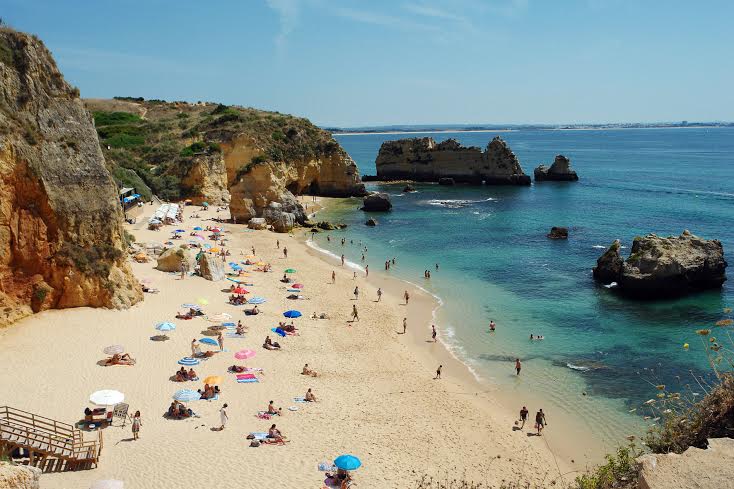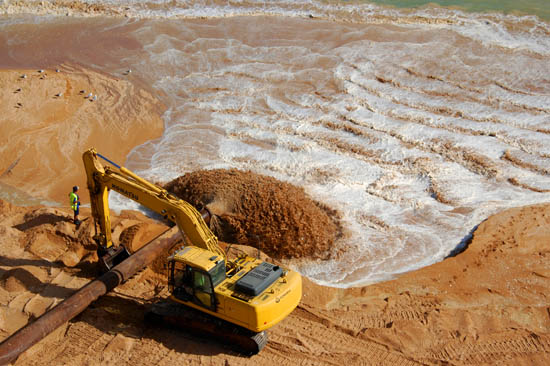 The association Almargem called, for Saturday, April 18, at 15 pm, a protest by «all the Lacobrigenses and friends of the Costa Dorada and the Algarve» near D. Ana beach, in Lagos, to «demand the immediate suspension of the process. destruction in progress' with the intervention of artificial feeding of the sand of this beach.
The association Almargem called, for Saturday, April 18, at 15 pm, a protest by «all the Lacobrigenses and friends of the Costa Dorada and the Algarve» near D. Ana beach, in Lagos, to «demand the immediate suspension of the process. destruction in progress' with the intervention of artificial feeding of the sand of this beach.
The Algarve environmental association believes that these works will “destroy the most beautiful beach in the world”.
The preparatory actions for these works, promoted by the Portuguese Environment Agency/ARH, started last monday and are intended to “protect the cliffs from erosion caused by the action of the tides”, as announced by the Câmara de Lagos.
The intervention has an estimated cost of 1,8 million euros, and the use of the beach is expected to be restricted until the 15th of June.
Last weekend, the local authority announced that at the end of this work, the width of Praia da D. Ana's sand will gain about 40 meters, «thus allowing more space for the many tourists who seek it, as well as the creation of an imperative safety zone next to the cliffs».
Almargem believes that this artificial recharging operation will have as an «obvious consequence» the «destruction of the ancestral and stunning seascape of Praia de D. Ana, the main reason for having recently been considered the “most beautiful beach in the world” (magazine Condé Nast Traveller) and the “best beach in Portugal” (TripAdvisor awards)».
For the Algarve environmental association, «as happened decades ago in Praia da Rocha, the artificial recharge of beaches with an increase in the respective dimensions and widths has, in fact, two priority objectives». On the one hand, «avoid the erosion of the cliffs, but above all try to protect the tourist buildings that have been improperly installed there in recent decades». On the other hand, «increase the occupancy capacity of the beaches, incorporating the growing flow of bathers as urbanization progressed in the surrounding areas».
Almargem: Artificial recharge is intended to «avoid the erosion of the cliffs, but above all to try to protect the tourist buildings that have been improperly installed there in recent decades»
Almargem defends, in a statement, that "these interventions, by themselves, do not eliminate the risk for bathers who frequent the beaches with unstable cliffs."
Citing existing technical data, the association states that “the real risk range covers 1,5 times the height of the cliff, that is, between 40 and 70 meters wide in most of the Algarve's beaches. It can thus be said that, with or without artificial re-feeding, all cliff beaches in the Algarve, especially those that are subject to a greater weight of urban occupation on the edge of the cliffs, will continue to put their users at risk».
«At any cost to the Algarve's tourist image, the only adequate and honest solution is to maintain a partial occupation of each beach, regardless of its size and capacity, delimiting the respective area on the land, with light stakes and rope fences. risk,” adds the association.
 Almargem emphasizes that «many thousands of euros have been spent in recent years with interventions on the edge of the cliffs, including the construction of pedestrian paths, viewpoints, protection barriers and footbridges, in some cases increasing the pressure on unstable rocks even more, as is the case , for example, in Praia Maria Luísa. This is in addition to the large millions employed in the heavier interventions of regularization of the cliffs and artificial re-feeding of the beaches». At Praia de D. Ana alone, it is estimated that the work will cost 1,8 million euros, a deal that environmentalists say is «doing at the expense of all of us».
Almargem emphasizes that «many thousands of euros have been spent in recent years with interventions on the edge of the cliffs, including the construction of pedestrian paths, viewpoints, protection barriers and footbridges, in some cases increasing the pressure on unstable rocks even more, as is the case , for example, in Praia Maria Luísa. This is in addition to the large millions employed in the heavier interventions of regularization of the cliffs and artificial re-feeding of the beaches». At Praia de D. Ana alone, it is estimated that the work will cost 1,8 million euros, a deal that environmentalists say is «doing at the expense of all of us».
The association also criticizes the fact that "little or nothing" was done, in its opinion, "to effectively delimit the risk zones on the ground for bathers", in addition to the "installation of discreet information panels and warning signs", the which allegedly indicates that "what truly matters for the responsible entities is not the safety of the people but the preservation of the image of idyllic beaches with wonderful cliffs, despite being naturally unstable".
In a long press release, Almargem considers that there are two other aspects that have been «deftly concealed»: «the environmental impact of the dredging of sands used for beach replenishment and the fundamental reason for the scarcity of sediments on the Algarve coast».
The association argues that the impact that dredging along the Algarve coast "has had on marine ecosystems and the fisheries resources that exist there" is not known, adding that it will also be important to know "what consequences the filling of beaches has on biodiversity from the intertidal zone, which is very rich in the central and western part of the Algarve».
Considering the context of the intervention on D. Ana beach «a lot more complicated than it seems at first sight», the Almargem Association ends up demanding from the Ministry of Environment «greater clarity of processes, namely with prior public discussion of the various programmed interventions».


















Comments